Part of a series of articles titled Alaska Park Science, Volume 18, Issue 1, Understanding and Preparing for Alaska's Geohazards.
Article
Volcanic Ash Resuspension from the Katmai Region
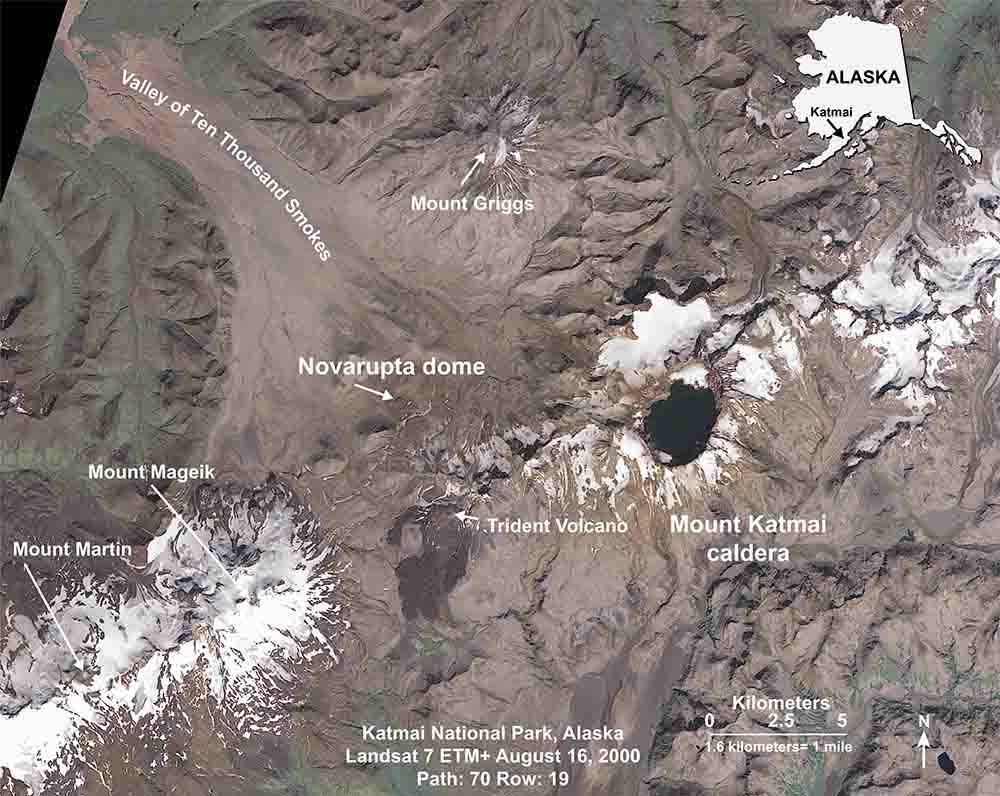
Image produced by Steve J. Smith. Modified from AVO image ID 2152
Volcanic ash is not only a hazard during an eruptive event; in strong winds, previously deposited loose volcanic ash can be picked up and reworked into dust clouds. Resuspension and transport of fine-grained volcanic ash from Katmai National Park and Preserve, Alaska has been observed and documented many times over the past several decades and has likely been occurring throughout the time interval since the 1912 Novarupta-Katmai eruption (Hadley et al. 2004). This eruption, the largest in the world during the 20th Century, produced approximately 4 cubic miles (17 cubic km) of ash deposits and 2.6 cubic miles (11 cubic km) of pyroclastic material that filled nearby valleys, creating what is today known as the Valley of Ten Thousand Smokes (VTTS; Fierstein and Hildreth 1992). Ash in this valley is up to 660 feet (200 m) thick and the valley remains almost entirely free of vegetation (Figure 1).
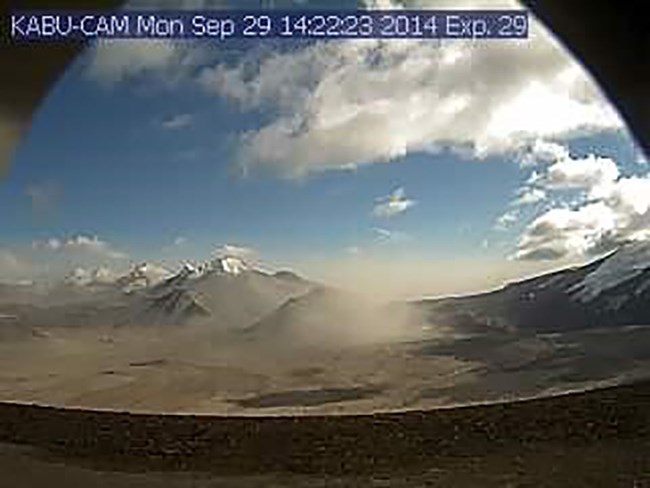
Volcanic ash describes fragments of volcanic material less than 0.08 inches (2 mm) in diameter. In the VTTS, ash and other fine-grained material can be picked up (reworked) into dust clouds during the spring and fall, or whenever strong northwesterly winds blow over the snow-free landscape. The ash is especially susceptible to reworking when the ground is very dry. These dust clouds have been observed visually by individuals downwind, in images acquired by remote web cameras, and also in satellite imagery (Figures 2, 3, and 4).
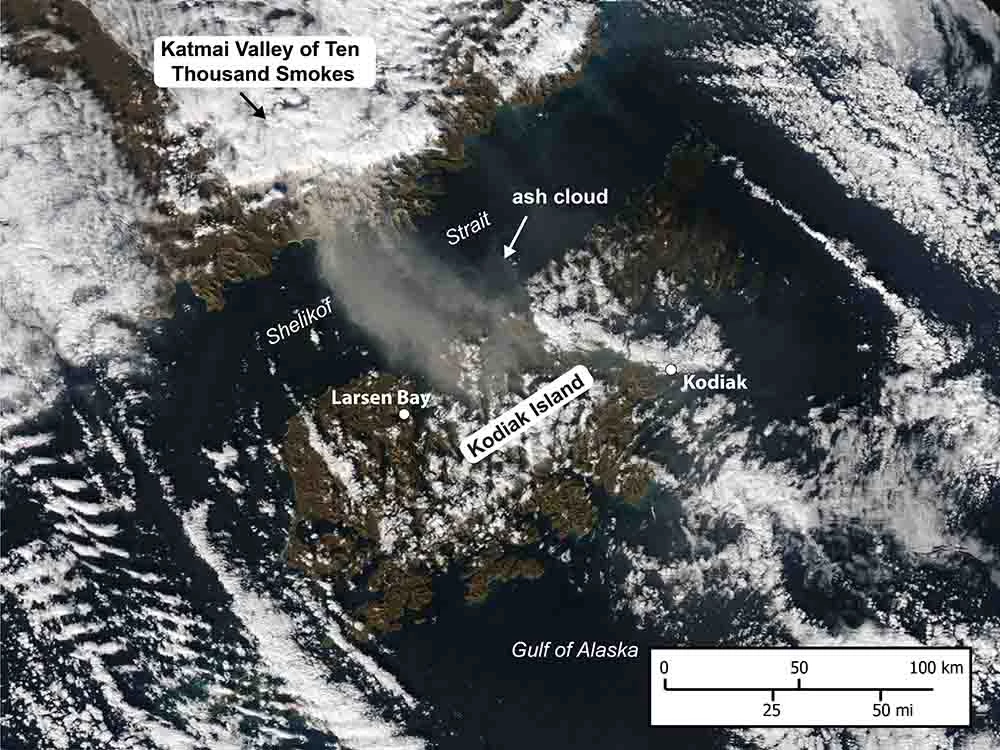
Image obtained October 5, 2014, courtesy of the National Aeronautics and Space Administration (NASA). AVO Image ID 133541.
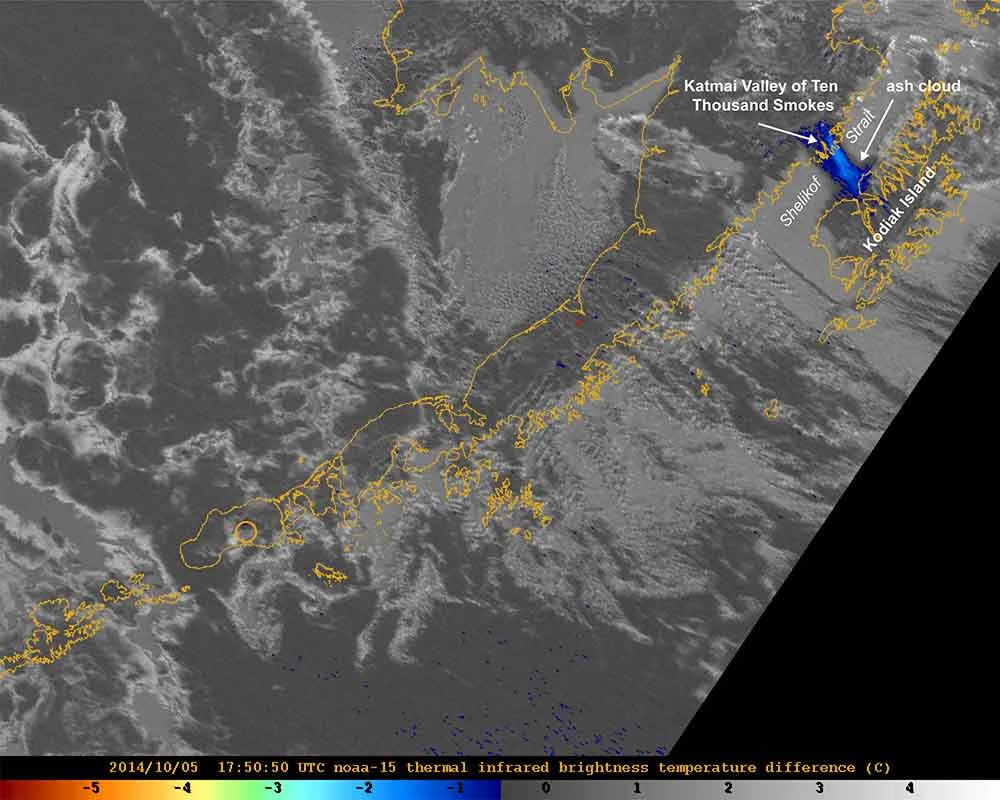
AVO image ID 80451.
Ash resuspension events originating in the Katmai VTTS have been observed and recorded about 30 times since 2003 (Figure 5) when the Alaska Volcano Observatory began actively recording them. The dust clouds produced by these events are typically concentrated between 4,000 and 11,000 feet (1–3.4 km) above sea level and have traveled as far as 155 miles (250 km), usually drifting southeast over Shelikof Strait, Kodiak Island and the Gulf of Alaska. Trace amounts of ash (typically less than 1/32 inch or 1 mm) have fallen on communities on Kodiak Island.
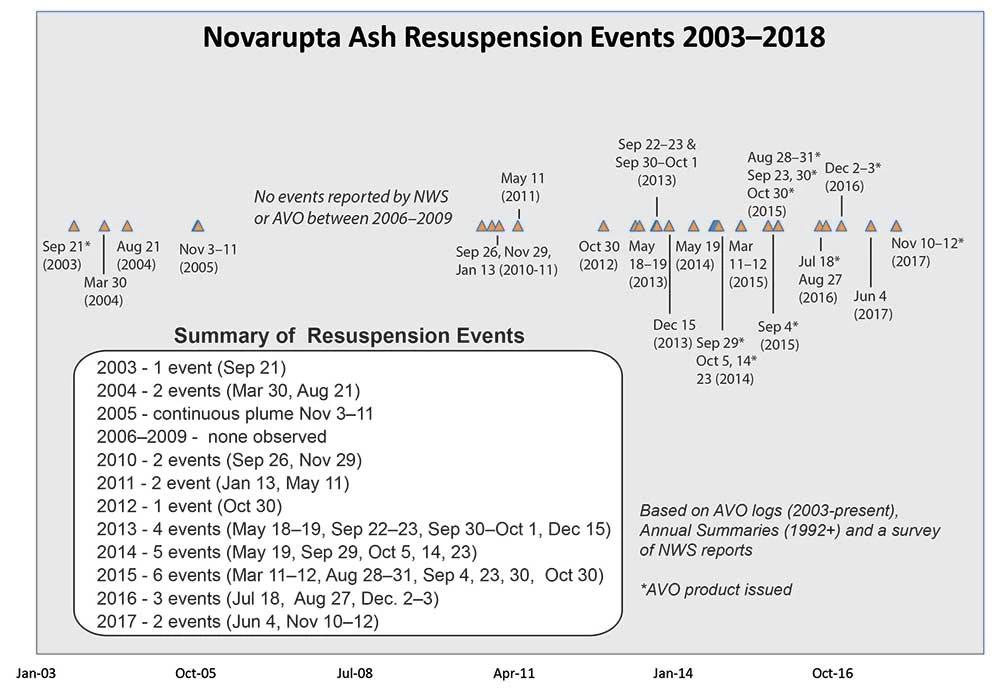
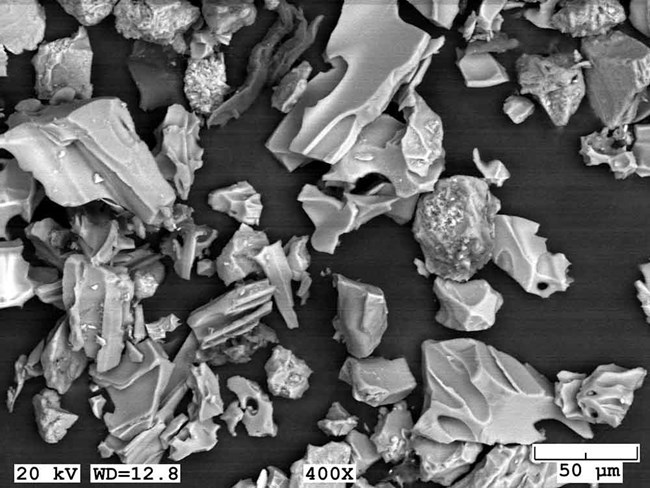
Hazards and Impacts Associated with Resuspended Ash
During dry conditions, strong winds in the Katmai region can pick up and transport fine ash. This resuspended ash is composed primarily of volcanic glass shards (Figure 6) and is physically identical to ash produced in volcanic eruptions. Thus, the resulting plume looks like that produced during an explosive volcanic eruption (Figure 6).
Likewise, these ash clouds, even when relatively dilute, can pose hazards to human health and aircraft operation (Hadley et al. 2004). Ash clouds produced during eruptions can abrade aircraft surfaces, such as cabin and cockpit windows, damage sensitive electronics, and erode and adhere to engine parts (Neal and Guffanti 2010). Resuspended volcanic ash plumes have not been well studied and much remains to be learned about the sizes and concentration of the ash particles and volumes mobilized. Moreover, impacts from the fallout of resuspended ash are not well known. The largest resuspension events observed so far only deposited trace amounts of ash (thicknesses less than 1/32 inch or 1 mm) on Kodiak Island communities. It is not known if this amount presents an air quality issue and thus a public health hazard.
Regardless, dust storms composed of resuspended ash within the Katmai region are likely to be hazardous to park visitors and staff owing to the high concentration of ash in dust clouds nearer to the source area (VTTS). Avoiding exposure, especially by people already at risk, such as children, the elderly, and those with existing respiratory or cardiovascular disease, is the best way to mitigate the hazard. If exposed to a dust storm in the VTTS, use of an industry-approved disposable N95 dust respirator mask is advised until the event ends. Because it is abrasive, resuspended ash may also irritate eyes and skin; this can be minimized by using eye goggles and protective clothing such as pants and long-sleeved shirts.
Ash Resuspension Monitoring
Ash Cloud Surveillance
The Alaska Volcano Observatory (AVO) and the National Weather Service (NWS) both monitor ash clouds using near-real-time satellite data. AVO reviews available satellite data once per day and has automated alarms that alert staff of possible ash clouds. The NWS monitors for ash clouds continuously, also relying on automated systems to alert staff of ash clouds. Both agencies work closely and coordinate when such events are recognized. During times when the NWS forecasts high winds in the Katmai region, both agencies pay special attention to satellite data for signs of resuspension.
Resuspension Modelling
Since resuspended ash clouds pose the same hazards as those produced during an explosive eruption, AVO strives to anticipate when conditions are suitable for resuspension events to occur. Volcanic ash within the VTTS will begin to remobilize once the stresses from surface winds exceed a threshold. At that point, ash can be entrained in the air along the ground surface in the valley. If the lower levels of the atmosphere are stable, then this remobilized ash layer may remain close to the ground surface (Figure 3). However, if the meteorological conditions are suitable for vertical mixing, the ash may be lofted several thousand feet, where it may then drift with the wind, predominantly southeast over Shelikof Strait and Kodiak Island.
AVO has modified their volcanic ash dispersion and deposition model (Ash3d; Schwaiger et al. 2012) to include the resuspension of ash deposits. Analysis of the meteorological and surface conditions (strength of the wind, atmospheric stability, precipitation, and snow cover) present during past occurrences of resuspended ash allows identification of the conditions conducive for generation of resuspension events. Thus, using numerical weather prediction forecast models, Ash3d can anticipate when resuspension events are most likely to occur.
For some events with particularly good satellite observations, it has been possible to estimate both the amount of ash in the atmosphere (Figure 7) and the height of the ash cloud, parameters crucial for determining the downwind aviation hazard. Moreover, these satellite observations have helped to constrain the Ash3d model for predicting the onset and cessation of events. Ash3d is currently run automatically at AVO, sending text and email alerts to AVO staff when resuspension events are expected. These alerts provide situational awareness to AVO staff, who then coordinate with the NWS.
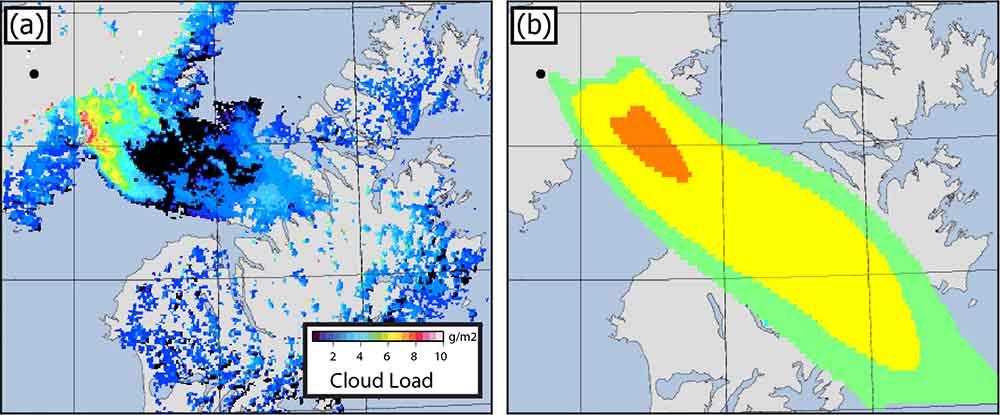
Air Quality Monitoring and Characterization of Deposits
Although aviation hazards are the more urgent concern with volcanic ash clouds, it is possible that dilute ash clouds can reduce the surface air quality sufficiently to pose a hazard to human health. To address these concerns, AVO, in partnership with the Alaska Department of Environmental Conservation-Air Quality Division (AK-DEC), deployed part-iculate instruments (PM-10, particulate matter of ≤10 microns in diameter) to Kodiak Island during the fall and spring months in 2015-2016 to monitor air quality impacts during ash resuspension events (Figure 8). These instruments were placed in two communities on Kodiak Island that historically have been impacted by resuspended volcanic ash: Larsen Bay and the city of Kodiak. During this time, only moderate resuspension events occurred, and recorded degradation of air quality associated with a few of these events with PM-10 values up to 60 µg/m3. These episodes did not exceed the Environmental Protection Agency (EPA) 24-hour PM-10 standard of 150 µg/m3; however, AVO continues to assess the forecast ground concentrations as well as air borne cloud load. The long-term impacts of resuspension and fallout of volcanic ash after large eruptions is becoming better documented (e.g., Gordian et al. 1996, Horwell and Baxter 2006, Thorsteinsson et al. 2012), but remains unknown from this region.
Samples of fallout from resuspended clouds collected during this short study, and others sent to AVO by citizens in Kodiak from past events, confirm that these ash clouds are composed predominantly of shards of volcanic glass. Even after more than 100 years of being deposited in the Katmai valley, these particles appear pristine and very similar to those deposited during an eruption.
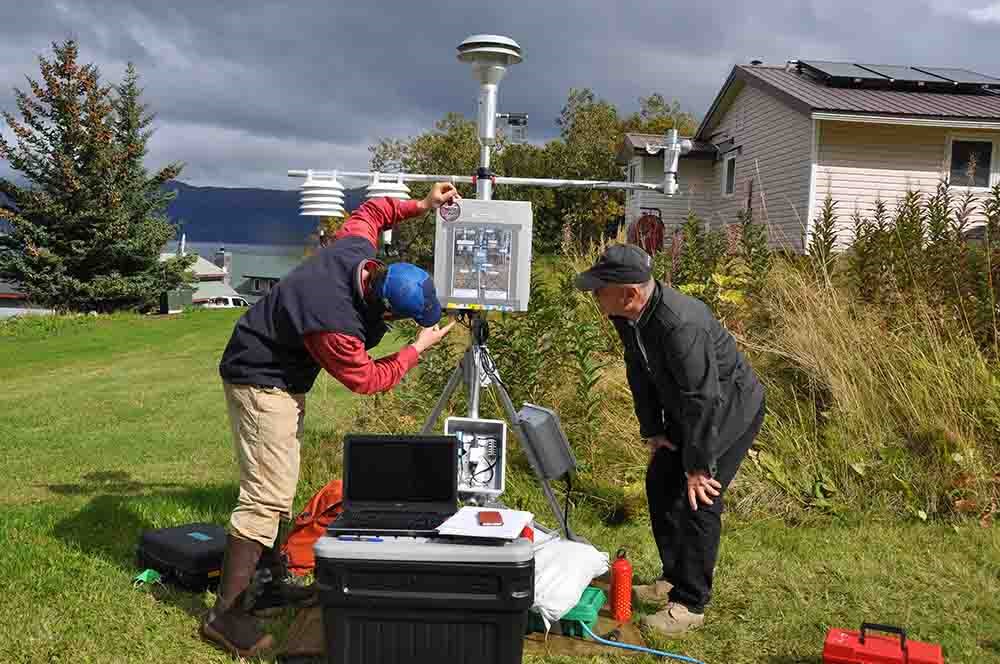
How the Public is Notified of Resuspension Events
The Alaska Volcano Observatory works closely with the National Weather Service, which has the responsibility to issue forecasts and statements of resuspended volcanic ash. These include forecasts of airborne ash hazards to aircraft, volcanic ash advisories, and forecasts of ashfall to communities and mariners. AVO also coordinates with the Alaska Department of Environmental Conservation, Division of Air Quality during ash resuspension, who has the responsibility to issue guidance on air quality hazards. In addition to these official warning products, AVO issues Information Statements during resuspension events from the Katmai region that clearly state they are not the result of an active volcanic eruption. Accordingly, since there is no eruption, AVO does not issue formal Volcanic Activity Notices (VANs) during resuspension events. The Information Statements are intended to corroborate products issued by the NWS and provide background on these events.
References
Fierstein, J. and Hildreth, W. 1992.
The plinian eruptions of 1912 at Novarupta, Katmai National Park. Alaska. Bulletin of Volcanology 54(8): 646–684.
Gordian, M. E., H. Ozkaynak, J. Xue, J., S. S. Morris, and J. D. Spengler. 1996.
Particulate air pollution and respiratory disease in Anchorage, Alaska. Environmental Health Perspectives 104(3): 290.
Hadley, D., G. L. Hufford, and J. J. Simpson. 2004.
Resuspension of relic volcanic ash and dust from Katmai: Still an aviation hazard. Weather and Forecasting 19(5): 829-840.
Horwell, C. J. and P. J. Baxter. 2006.
The respiratory health hazards of volcanic ash: A review for volcanic risk mitigation. Bulletin of Volcanology 69(1): 1-24.
Neal, C. A. and M. Guffanti. 2010.
Airborne volcanic ash—a global threat to aviation. U.S. Geological Survey Fact Sheet 2010–3116, 6 p.
Schwaiger, H. F., R. P. Denlinger, and L. G. Mastin. 2012.
Ash3d: A finite-volume, conservative numerical model for ash transport and tephra deposition. Journal of Geophysical Research 117(B4).
Thorsteinsson, T., T. Jóhannsson, A. Stohl, and N. I. Kristiansen. 2012.
High levels of particulate matter in Iceland due to direct ash emissions by the Eyjafjallajökull eruption and resuspension of deposited ash. Journal of Geophysical Research 117(B9).
Last updated: December 30, 2019
